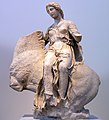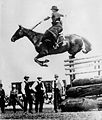Ladies seat

In the women's seat, the rider sits sideways on the horse . Both legs are on one side of the horse, usually on the left. The side saddle , a riding saddle for horses, was developed in parallel to the side seat . The side saddle is placed on the saddle position , the area behind the withers and fastened with the saddle girth .
history
Even in ancient times people rode sideways. For example, there are depictions of the Celtic goddess Epona in the side seat. Since there was no suitable side seat saddle, it was only possible to ride at the crotch . Until the end of the 13th century, women and men sat on horseback in the same way. Women wore trousers for riding, although in Europe it was generally under the skirt.
The side seat appeared among noble women only in the 14th century when they were concerned with the development of a saddle suitable for the side seat. Anna of Bohemia was already using a side saddle in the 13th century and thus created a preliminary stage for the Sambue.
Aura , goddess of the morning breeze in the side seat, Greece, around 380 BC Chr.
Penthesilea as one of the Nine Good Heroes in the Cross Seat, France, around 1460
Marie Louise d'Orléans Queen of Spain, astride with a wide skirt and blanket to protect her skirt, 1697
Wilhelmine of Prussia on horseback in the German style, 1789
Side seat with footrest: The ride on the donkey, Eva Gonzalès , 1880
Therèse Renz in the piaffe, 1903
Elisabeth II on Burmese , 1986
Alexandrine of Prussia , equestrian statue in Ludwigslust , 2003
Sambue
The sambue became common in the 14th century and was a straw-padded riding cushion with a backrest and footrest. On the Sambue you not only sat very unsteadily, but also across the horse. The horse could not be influenced and lively gaits with a suspension phase could not be sat. For this reason, tenters with soft and comfortable aisles were preferred and were accordingly valuable. The sambue was therefore mainly widespread among the nobility . Women still sat astride horses on fast rides through rough terrain.
The Sambue was in need of improvement. Anna of England (1366–1394) only put one foot on the left footrest to sit more securely.
Fork saddle
The sloping seat is attributed to Katharina von Medici . She slapped her right leg over the pommel and used a stirrup instead of the footrest for her left foot. This allowed her to sit more securely than on the Sambue and still wear a long skirt. In the inclined seat, the rider has her shoulders almost parallel to the horse's shoulders and can act on the horse. Around 1580 the pommel was replaced by a fork with two horns at the French royal court, so that the right thigh came to rest between the two horns and allowed a more stable seat. In this fork saddle it was possible to ride hunts and jump over small obstacles.
The side saddle is usually left-seated, meaning the legs are on the left side of the horse. The right-seated side saddle comes from falconry because the falcon was carried on the left hand during the hunt. It was the female riders who contributed to the further development of the side saddle over the centuries.
It was not easy to sit correctly in the fork saddle. To compensate for the pull of the legs on the left side, one tended to sit too far to the right so that the center of gravity was no longer in the middle. The fork offered too little support and it was difficult to provide assistance. Nevertheless, the fork saddle was widespread, especially among the English nobility. There were many noble women on the continent who continued to sit astride horseback, such as Diane de Poitiers (1499–1566, mistress of Henry II of France ), Marie Antoinette (1755–1793) and Catherine the Great (1729–1796) .
Three horn saddle
The third horn, the leaping head, was invented towards the end of the 18th century and made the side saddle much safer. It is angled downwards, lies over the left thigh and ensures a firm fit in all situations. In the three-horn saddle you could jump higher obstacles.
The three-horn saddle began to spread across the continent for women from 1830. However, it did not immediately replace the normal saddle. In France, Spain and Germany in particular, women continued to sit astride, in the “German way”, on horseback, especially when hunting. For this purpose, a long split skirt was usually worn, which could be buttoned up and unbuttoned.
The spread of the side saddle also for jumping led to accidents in which the riders were injured because they could not get off the horse. One reason for this was unsuitable, baggy clothing that got caught on the saddle. Therefore a " safety riding skirt " was developed that would not get caught on the saddle in the event of a fall.
Modern side saddle

The horn on the right side of the saddle had become superfluous and disappeared from around 1870. The modern side saddle therefore only has two horns. From around 1890 the upholstery became flatter and more functional and the saddle lighter. The balance strap that improved the saddle position was added. Thanks to these improvements, the side saddle caught on on the continent in the 19th century and was dominant in the second half of the 19th century.
Despite the positive development, the women's saddle is inferior to the normal saddle: The right leg and the cross action by opposing sitting were missing to provide assistance, and the saddle is dangerous in the event of a fall, as the rider often cannot get away from the saddle.
As a result, from 1900 onwards, women increasingly sat astride horses again, which led to public discussions. After the turn of the century, doctors also campaigned for the women's seat to be abolished, as it put pressure on the internal organs in combination with the corset. At this time, jodhpur pants also appeared. Anita Augspurg was one of the proponents of the manor house .
However, there were also votes against, for example the magazine Die Woche 1912 said:
“Just as the warning about the side seat is justified, which in the event of a fall poses greater danger as the foot can easily get caught in the fork and in the bracket, this seat is always preferred to the mansion. The line in the side seat is by far a more elegant (...) "
It was only after the First World War that the side saddle was displaced and banned in Germany for heavy jumping in 1928.
For riding in the side saddle, the rider wears ordinary breeches with riding boots and an apron or riding skirt over them . Imaginative riding dresses with wide skirts are also popular for shows. Today there is the side saddle dressage freestyle, in which baroque horse breeds are presented in stylish costumes . Side saddle dressage is also a sporting highlight.
Lady seat and discrimination
In the 19th century in Anglo-Saxon countries, ostensibly for reasons of morality, women were expected to ride in the lady's seat. Women who did not comply were often discriminated against.
At the beginning of the 20th century, Yemeni Jews were discriminated against by being obliged to ride in the lady’s seat.
Sharia and motorcycle
Since 2013, women in the Indonesian Sharia stronghold of Lhokseumawe in the province of Aceh have been forced to ride in the women's seat on motorcycles . The reason is Islamist ideas on the subject of "hymen" and morality. The mayor of Lhokseumawe Suaidi Yahy claims: "With this ban we want to honor women because they are fragile beings". The Indonesian central government is trying to stop this ban. Today, however, women who normally sit on the pillion in Lhokseumawe are persecuted and punished by the moral police .
motorcycle
In Germany, since 1956, women are no longer allowed to ride in the women's seat on motorcycles for safety reasons. For this purpose, Vespa made a new development available with the Denfeld seat, as the women's seat was particularly popular with scooters.
literature
- Michaela Otte: History of riding from antiquity to modern times. FN Verlag, 1994, ISBN 3-88542-255-7 .
Web links
Individual evidence
- ^ Therese Renz
- ↑ Agnes Strickland: Berengaria of Navarre. Anne of Bohemia. Lea & Blanchard, 1841, p. 309.
- ^ Antonia Fraser: The Warrior Queens. Anchor Books, New York 1990, ISBN 0-679-72816-3 .
- ↑ Max Jähns : Horse and Rider in Life, Language, Faith and History of the Germans. Volume 1, FW Grunow, Leipzig 1872.
- ↑ Clara Brockmann: Letters from a German girl from the southwest. Berlin 1912, p. 118.
- ↑ J. Veit (Ed.): Handbuch der Gynäkologie. Volume 2, 2nd edition. Wiesbaden 1907.
- ↑ Aviva Klein-Franke: The Jews in Yemen. P. 259.
- ↑ The myth of the hymen. In: Tagesanzeiger. 23rd August 2013.
- ↑ Anthony Bond: Islamic province bans women pillion passengers from straddling motorbikes to protect their 'morals' in Indonesia. In: Daily Mail. January 3, 2013.
- ↑ Hotli Simanjuntak: Local Officials delay sidesaddle regulation. In: The Jakarta Post. January 8, 2013.
- ↑ Going sidesaddle in Lhokseumawe. January 7, 2013.
- ^ Angela Dewan: Morality Police Target Women in Indonesian Shariah Stronghold. ( Memento of October 17, 2016 in the Internet Archive ) July 23, 2013.
- ^ Human Rights Watch World Report 2014 Indonesia
- ↑ BGL No. 19 of April 30, 1956, § 35a StVZO.
- ^ Lutz-Ulrich Kubisch, Günther Uhlig: Vespa. 1st edition. Motorbuch Verlag, Stuttgart 2014, ISBN 978-3-613-03672-7 , p. 56.















